|
|
This ‘composed documentary’ explores the experiences of transplant patients and the extraordinary issues raised by this invasive, last-option medical procedure. It weaves intensely personal narratives, often recorded at the bedside, with the sounds of the hospital environment, which can have an enormous effect on patients, shifting unpredictably from comforting to irritating, from reassuring to alarming. During my time at the Harefield transplant centre with photographer Tim Wainwright, I noticed that noise seems to come in waves: sometimes it is quiet enough to hear nurses' uniforms swishing, birds singing outside and the snap of latex gloves, but the atmosphere regularly builds to a cacophony of bleeps, bells, phones, pagers, voices, trolleys, bins, bags and plastic apron dispensers. My observations and interviews confirm anthropologist Tom Rice's assertion that in hospitals sound takes on "a more affective quality because of the drought in other sensory modalities." Particularly if they are restricted to bed, what a patient sees is limited, smells are generally overpowered by disinfectant, and the food is bland. Consequently, hearing becomes arguably the most important sense for understanding the environment and making sense of one's experience. All of the people whose voices are heard in this piece have had a heart and/or lung transplant or were waiting for one when I met them. Some have since died; others, including Ian (left), who lived with two ventricular assist devices (VADs) plumbed in through his abdomen for more than a year while waiting for a new heart, are doing well. All the sounds were recorded within the transplant centre, though some have been twisted and shaped afterwards, often in response to the comments or stories of patients. The piece hovers on the borders between sound and music, documentary and sound art, exploring what Rice calls 'the cacophony of disease'.
Photogaphs by Tim Wainwright. The hospital residency was funded by the Arts Council of England and supported by Royal Brompton and Harefield Arts. |
|

